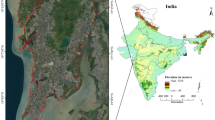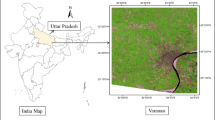Abstract
Urban heat island (UHI) has been a detrimental problem over the last decades. Also, climate change has obtained more attention due to increased urbanization. Turkey is one of the countries experiencing a rapid urbanization which has resulted in significant UHI impacts on the regional climate and environment. This study was conducted in Osmaniye city, Turkey, where there is a need to determine the effects of land-use/land-cover changes (LUCC) on the UHI using Landsat images. The geospatial analyses were undertaken using USGS/NASA Enhanced Thematic Mapper Plus geospatial data from 2000 to 2018. The results showed that percent cover of urban areas significantly increased from 6.13 to 17.76%, broad-leaved forest cover decreased from 14.2 to 11.6%, road and rail network cover increased from 5.23 to 10.85%, and coniferous forest cover decreased from 15.85 to 9.02% between 2000 and 2018. During the process of urbanization from 2000 to 2018, most of the bare land cover was converted to agricultural lands and urbanized areas due to vegetative degradation, and industrial units cover increased from 7.76 to 9.53%. The land surface temperature was 35.57 °C for approximately 25% of the study area in 2000, while the same temperature was calculated for 76% of the study area in 2018. The results suggest that LUCC from vegetation to urbanized areas has significantly increased the land surface temperature. This implies that the application of remote sensing technique could help to design methods to mitigate UHI effects by estimating future land-use/land-cover change in urban areas.


Similar content being viewed by others
References
Agbor, C. F., & Makinde, E. O. (2018). Land surface temperature mapping using geoinformation techniques. Geoinformatics FCE CTU, 17(1), 17.
Atasoy, M. (2018). Monitoring the urban green spaces and landscape fragmentation using remote sensing: A case study in Osmaniye, Turkey. Environmental Monitoring and Assessment, 190(12), 713.
Atasoy, M., Anderson, C. J., & Atasoy, F. G. (2018). Evaluating the distribution of invasive woody vegetation around riparian corridors in relation to land use. Urban Ecosystems, 21(3), 459–466.
Bilgili, B. C., Şahin, Ş., Yilmaz, O., Gürbüz, F., & Arici, Y. K. (2013). Temperature distribution and the cooling effects on three urban parks in Ankara, Turkey. International Journal of Global Warming, 5(3), 296. https://doi.org/10.1504/ijgw.2013.055364.
Bokaie, M., Zarkesh, M. K., Arasteh, P. D., & Hosseini, A. (2016). Assessment of Urban Heat Island based on the relationship between land surface temperature and land use/land cover in Tehran. Sustainable Cities and Society, 23, 94–104. https://doi.org/10.1016/j.scs.2016.03.009.
Büyükbeşe, T., & Aslan, H. (2019). Psikolojik sermaye ve duygusal emeğin örgütsel bağlılık üzerindeki etkisi. İşletme Araştırmaları Dergisi, 11(2), 949–963.
Chander, G., Markham, B. L., & Helder, D. L. (2009). Summary of current radiometric calibration coefficients for Landsat MSS, TM, ETM+, and EO-1 ALIsensors. Remote Sensing of Environment, 113(5), 893–903.
Chen, Y., Wang, J., & Li, X. (2002). A study on urban thermal field in summer based on satellite remote sensing. Remote Sensing for Land and Resources, 4, 55–59.
Chen, X., Zhao, H., Li, P., & Yin, Z. (2006). Remote sensing image-based analysis of the relationship between urban heat island and land use/cover changes. Remote Sensing of Environment, 104(2), 133–146. https://doi.org/10.1016/j.rse.2005.11.016.
Chun, B., & Guldmann, J. (2014). Spatial statistical analysis and simulation of the urban heat island in high-density central cities. Landscape and Urban Planning, 125, 76–88. https://doi.org/10.1016/j.landurbplan.2014.01.016.
Congalton, R. G. (1991). A review of assessing the accuracy of classifications of remotely sensed data. Remote Sensing of Environment, 37(1), 35–46.
Deosthali, V. (2000). Impact of rapid urban growth on heat and moisture islands in Pune City, India. Atmospheric Environment, 34, 2745–2754.
Dwivedi, A., & Mohan, B. (2018). Impact of green roof on micro climate to reduce Urban Heat Island. Remote Sensing Applications: Society and Environment, 10, 56–69. https://doi.org/10.1016/j.rsase.2018.01.003.
El-Hattab, M., Amany, S. M., & Lamia, G. E. (2017). Monitoring and assessment of urban heat islands over the Southern region of Cairo Governorate, Egypt. The Egyptian Journal of Remote Sensing and Space Science. https://doi.org/10.1016/j.ejrs.2017.08.008.
Estoque, R. C., & Murayama, Y. (2015). Classification and change detection of built-up lands from Landsat-7 ETM+ and Landsat-8 OLI/TIRS imageries: A comparative assessment of various spectral indices. Ecological Indicators, 56, 205–217. https://doi.org/10.1016/j.ecolind.2015.03.037.
Estoque, R. C., Murayama, Y., & Myint, S. W. (2017). Effects of landscape composition and pattern on land surface temperature: An urban heat island study in the megacities of Southeast Asia. Science of the Total Environment, 577, 349–359. https://doi.org/10.1016/j.scitotenv.2016.10.195.
Feizizadeh, B., Blaschke, T., Nazmfar, H., Akbari, E., & Kohbanani, H. R. (2013). Monitoring land surface temperature relationship to land use/land cover from satellite imagery in Maraqeh County, Iran. Journal of Environmental Planning and Management, 56(9), 1290–1315.
Fu, P., & Weng, Q. (2017). Responses of urban heat island in Atlanta to different land-use scenarios. Theoretical and Applied Climatology, 133(1–2), 123–135. https://doi.org/10.1007/s00704-017-2160-3.
Fung, T., & Siu, W. (2000). Environmental quality and its changes, an analysis using NDVI. International Journal of Remote Sensing, 21(5), 1011–1024.
Güngör, S., & Polat, A. T. (2017). The evaluation of the urban parks in Konya province in terms of quality, sufficiency, maintenance, and growth rate. Environmental Monitoring and Assessment, 189(4), 172.
Hosseini, A., Pourahmad, A., & Pajoohan, M. (2015). Assessment of institutions in sustainable urban-management effects on sustainable development of Tehran: Learning from a developing country. Journal of Urban Planning and Development, 142(2), 05015009.
Howard, L. (1833). Climate of London deduced from meteorological observation. Harvey and Darton, 1(3), 1–24.
Kilinc, G., & Gulersoy, N. Z. (2011). Evaluation of the potential for districts/counties to become provinces with respect to the level of urbanization in Turkey. European Planning Studies, 19(8), 1557–1580.
Laosuwan, T., & Sangpradit, S. (2012). Urban heat island monitoring and analysis by using integration of satellite data and knowledge based method. International Journal of Development and Sustainability, 1(2), 99–110.
Li, J., Song, C., Cao, L., Zhu, F., Meng, X., & Wu, J. (2011). Impacts of landscape structure on surface urban heat islands: A case study of Shanghai, China. Remote Sensing of Environment, 115(12), 3249–3263. https://doi.org/10.1016/j.rse.2011.07.008.
Li, H., Zhou, Y., Li, X., Meng, L., Wang, X., Wu, S., et al. (2018). A new method to quantify surface urban heat island intensity. Science of the Total Environment, 624, 262–272. https://doi.org/10.1016/j.scitotenv.2017.11.360.
Lobo, A., Legendre, P., Rebollar, J. L. G., Carreras, J., & Ninot, J. M. (2004). Land cover classification at a regional scale in Iberia: Separability in a multi-temporal and multi-spectral data set of satellite images. International Journal of Remote Sensing, 25(1), 205–213.
Mirzaei, P. A. (2015). Recent challenges in modelling of urban heat island. Sustainable Cities and Society, 19, 200–206.
Nastran, M., Kobal, M., & Eler, K. (2018). Urban heat islands in relation to green land use in European cities. Urban Forestry & Urban Greening. https://doi.org/10.1016/j.ufug.2018.01.008.
Osmaniye Municipality. (2018). The municipality of Osmaniye City. Retrieved July 31, 2018 from http://osmaniye-bld.gov.tr/
Soysal, A., Özçalıcı, M., & Güneysu, F. (2010). The contribution of undergraduate students to region economics: A research on undergraduate students. In 1st International Boarder Trade Congress (Vol. 1(1)). Retrieved January 15, 2019 from http://iibf.kilis.edu.tr/bordertrade/files/Kongre_kitapcigi.pdf
Sun, Q., Tan, J., & Xu, Y. (2010). An ERDAS image processing method for retrieving LST and describing urban heat evolution: A case study in the Pearl River Delta Region in South China. Environmental Earth Sciences, 59(5), 1047–1055.
TUIK. (2018). Turkish Statistical Institute addressed based population registration system. Retrieved October 15, 2018 from www.tuik.gov.tr/PreIstatistikTablo.do?istab_id=1590.
Weng, Q., & Lu, D. (2008). A sub-pixel analysis of urbanization effect on land surface temperature and its interplay with impervious surface and vegetation coverage in Indianapolis, United States. International Journal of Applied Earth Observation and Geoinformation, 10(1), 68–83.
Yalcin, G. (2014). Urban activities in the view of the sustainable development. Procedia Technology, 12, 566–571.
Yang, C., He, X., Yan, F., Yu, L., Bu, K., Yang, J., et al. (2017). Mapping the influence of land use/land cover changes on the urban heat island effect—A case study of Changchun. China. Sustainability, 9(2), 312. https://doi.org/10.3390/su9020312.
Yuan, F., & Bauer, M. E. (2007). Comparison of impervious surface area and normalized difference vegetation index as indicators of surface urban heat island effects in Landsat imagery. Remote Sensing of Environment, 106(3), 375–386. https://doi.org/10.1016/j.rse.2006.09.003.
Acknowledgements
The author wishes to thank Dr. Filiz Güneysu Atasoy for compiling the data and anonymous reviewers for their constructive comments.
Author information
Authors and Affiliations
Corresponding author
Additional information
Publisher's Note
Springer Nature remains neutral with regard to jurisdictional claims in published maps and institutional affiliations.
Rights and permissions
About this article
Cite this article
Atasoy, M. Assessing the impacts of land-use/land-cover change on the development of urban heat island effects. Environ Dev Sustain 22, 7547–7557 (2020). https://doi.org/10.1007/s10668-019-00535-w
Received:
Accepted:
Published:
Issue Date:
DOI: https://doi.org/10.1007/s10668-019-00535-w




